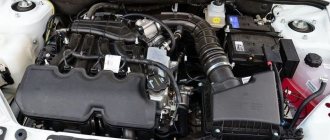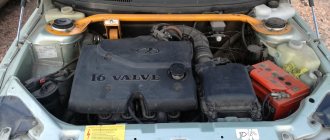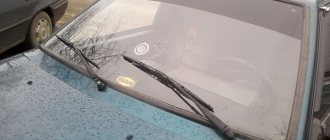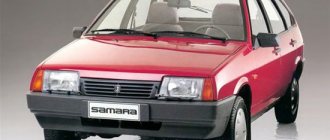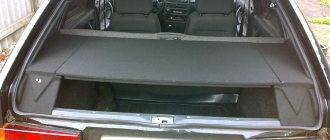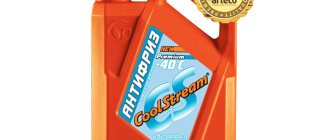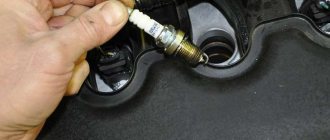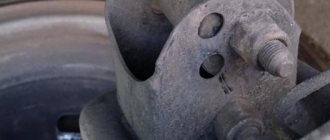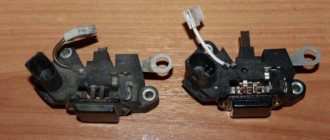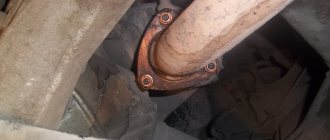Dimensions Lada 2109 restyling 1991, hatchback 5 doors, 1st generation
04.1991 — 08.2006
| Options | Dimensions | Weight, kg |
| 1.1MT 21091 | 4006 x 1650 x 1402 | 915 |
| 1.3MT 21090 | 4006 x 1650 x 1402 | 915 |
| 1.5i MT 21093-20 Standard | 4006 x 1650 x 1402 | 920 |
| 1.5i MT 21093-21 Normal | 4006 x 1650 x 1402 | 920 |
| 1.5i MT 21093-22 Lux | 4006 x 1650 x 1402 | 920 |
| 1.5 MT 21093-00 Standard | 4006 x 1650 x 1402 | 945 |
| 1.5i MT 21093-20 Standard | 4006 x 1650 x 1402 | 945 |
| 1.5i MT 21093-21 Normal | 4006 x 1650 x 1402 | 945 |
| 1.5i MT 21093-22 Lux | 4006 x 1650 x 1402 | 945 |
| 1.5 MT 21093-01 Norm | 4006 x 1650 x 1402 | 945 |
| 1.5 MT 21093-02 Lux | 4006 x 1650 x 1402 | 945 |
| 1.5 MT 21093-20 Standard | 4006 x 1650 x 1402 | 945 |
| 1.5 MT 21093-21 Norm | 4006 x 1650 x 1402 | 945 |
| 1.5 MT 21093-22 Lux | 4006 x 1650 x 1402 | 945 |
Description and modifications
As such, a “nine” engine does not exist in nature. At least, the AvtoVAZ plant did not produce it. All 2109 models were equipped with a figure-eight power unit and its modifications. Of course, in many documents you can find the VAZ 2109 engine, but this is deception or ignorance.
But in the technical documentation of the manufacturer you cannot find information about the 2109 engine, since such an engine does not exist. Over the entire period of their production, all “nines” were equipped with engines with the following markings: VAZ-21081 (1.1 8V), VAZ-2108 (1.3 8V), VAZ-21083 (1.5 8V), VAZ- 2111-80 (1.5i 8V) and VAZ-11183-20 (1.6i 8V).
Dimensions Lada 2109 1987, hatchback 5 doors, 1st generation
03.1987 — 08.1993
| 1.1MT 21091 | 4006 x 1650 x 1402 | 915 |
| 1.3MT 21090 | 4006 x 1650 x 1402 | 915 |
| 1.5 MT 21093-00 Standard | 4006 x 1650 x 1402 | 945 |
| 1.5 MT 21093-01 Norm | 4006 x 1650 x 1402 | 945 |
| 1.5 MT 21093-02 Lux | 4006 x 1650 x 1402 | 945 |
| 1.5 MT 21093-20 Standard | 4006 x 1650 x 1402 | 945 |
| 1.5 MT 21093-21 Norm | 4006 x 1650 x 1402 | 945 |
| 1.5 MT 21093-22 Lux | 4006 x 1650 x 1402 | 945 |
Repair and service
On average, repairs to internal combustion engines of VAZ 2109 modifications are done based on mileage. This figure is about 200,000 km. Engine overhauls are carried out similarly to any Zhiguli power unit. Since, compared to the Volgovsky engine, the Vazovsky is quite small, motorists often do the bulkhead in their garage with their own hands.
The 2109 engine is highly repairable, since the cast iron block is quite difficult to destroy, and the cost of the head is low, which allows you to repair the internal combustion engine cheaply and without much expense with your own hands. Another positive factor in the repair is that the power unit is simple in design and even inexperienced car enthusiasts are able to carry out minor repairs to the VAZ 2109 engine with their own hands.
The main problems that many people face include: changing the oil in the VAZ 2109 engine, replacing spark plugs and high-voltage wires, as well as overhauling and adjusting the carburetor. By the way, almost all engines were equipped with an excellent injection element, which everyone knows as “Solex”.
Another question that car enthusiasts often ask is how much oil should be poured into the engine? This indicator depends on the type of motor. For example, for a VAZ-21081 this will be one indicator, but for a VAZ −11183-20 it will be completely different. Therefore, if a motorist wants to know how much oil is in his power unit, he needs to look at the technical documentation.
Technical characteristics of the VAZ 2109 “Nine”
VAZ-2109 “Sputnik”/Samara (informal name “Nine”) is a Soviet and Russian front-wheel drive car of group II small class with a hatchback body. Developed and mass-produced at the Volzhsky Automobile Plant in 1987-2004. From 2004 to the end of 2011, the VAZ-21093 version was assembled from vehicle kits in Ukraine. It is a five-door modification of the VAZ-2108 in the Lada Sputnik family of models.
"Nine" "VAZ 2109"
1. Performance characteristics of the VAZ 2109 nine
Maximum speed: 160 km/h Acceleration time to 100 km/h: 13 sec Fuel consumption per 100 km in the city: 10 l Fuel consumption per 100 km on the highway: 5.7 l Fuel consumption per 100 km in the combined cycle: 7.3 l Fuel tank volume: 43 l Vehicle curb weight: 945 kg Permissible gross weight: 1370 kg Tire size: 165/70 SR13
2. Engine characteristics
Location: front, transverse Engine capacity: 1500 cm3 Engine power: 78 hp Number of revolutions: 5400 Torque: 115/3000 N*m Power system: Distributed injection Turbocharging: no Gas distribution mechanism: OHC Cylinder arrangement: In-line Number of cylinders: 4 Cylinder diameter: 82 mm Piston stroke: 71 mm Compression ratio: 9.9 Number of valves per cylinder: 2 Recommended fuel: AI-95
3. Brake system
Front brakes: Disc Rear brakes: Drum
4. Steering
Steering Type: Rack and Pinion Power Steering: No
5. Transmission
Drive: Front Number of gears: manual gearbox - 5 Gear ratio of the main pair: 3.9
6. Suspension
Front suspension: Shock absorber Rear suspension: Coil spring
7. Body
Body type: hatchback Number of doors: 5 Number of seats: 5 Vehicle length: 4006 mm Vehicle width: 1650 mm Vehicle height: 1402 mm Wheelbase: 2460 mm Front track: 1400 mm Rear track: 1370 mm Ground clearance (clearance): 160 mm Maximum trunk volume: 1000 l Minimum trunk volume: 270 l
8. Production
Year of manufacture: from 1987 to 2006
Lada 1999, 68 l. With. - other
Ulan-Ude
Lada 2109, 1994
95 000 ₽
Tomsk
Lada 2109, 2001
40 000 ₽
Omsk
Lada 2109, 1995
45 000 ₽
Kiselevsk
Lada 2109, 1994
45 000 ₽
See more cars on Drome
Participate in the discussion can only registered users.
Login Register
VAZ 2109 body: introduction
Inside, the car body practically does not cause any complaints from car owners, despite its small, compact dimensions. However, there is enough space for a trip of five people of average build. The low-mounted dashboard is quite easy to operate; if necessary, you can build in modern electronic components, but this will require you to spend a significant amount of money.
VAZ 2109 body dimensions
There is a slight drawback in terms of the material construction of the interior, which is made of plastic. This is a significant drawback, since such a building periodically rattles and needs technical modernization to strengthen it. However, this is quite easy to do and you don’t have to spend a lot of money.
Price and options
The “nine” did not have a special level of comfort, so there is simply nothing to describe to a greater extent. Even then, it was in many ways superior to foreign cars. But the domestic hatchback was distinguished by its maintainability and the presence of the necessary parts.
The steering wheel did not have a hydraulic booster, so you had to physically work hard. There was a standard heater, a simple steering wheel and standard seats with seat belts installed.
It was possible to adjust the external mirrors from the interior using a mechanical lever. Today, the VAZ 2109 can only be purchased on the secondary market. Usually the price tag for this car is low, so you can buy a car on the go from 60,000 rubles.
Control dimensions of the VAZ 2109 body
VAZ 2109 control body dimensions
The body has a rather short length - 4006 mm, which is an obvious advantage of the car, since compactness is important in urban environments. If we compare the manufacturer’s previous models, the body length of the VAZ 21099 was reduced by 120 mm, while there was 60 mm more space inside thanks to rational and correct design solutions.
The first production VAZ 2109 cars had a body width of 1650 mm, however, after a few months, the developers managed to reduce it by 30 mm to 1620 mm, this further increased the compactness of the body.
Body dimensions of VAZ 2109 and VAZ 2108
The body height is approximately 1402, which is 30 mm comparatively less than the body of its predecessor models. But the designers were able to compensate for the free space by creating car windows in a convex shape. On the one hand, this made it possible to increase the amount of free space, on the other, it made the vehicle more presentable.
The luggage compartment of the VAZ 2109 deserves special attention, which at one time made a real splash on the passenger car market. Even today, this almost revolutionary design feature has not lost its practical relevance.
VAZ 2109 body sizes
The standard trunk capacity of the Nine is 330 liters, but if necessary, it can be expanded to 640 liters by folding the rear seats. All this can be done in a couple of minutes and does not require much effort.
The front wheel track is 1400 mm, and the rear wheel track is 1370 mm. The compact dimensions of the VAZ 2109 body make it possible to efficiently transport small-sized cargo around the city, even during rush hour when there are a lot of traffic jams.
Control body size VAZ 21099
Note. The compact dimensions of the “nine” create opportunities for overtaking, since large passenger cars are practically unable to maneuver in traffic jams due to the lack of sufficient free space.
Advantages and disadvantages
Pros of the car
- Inexpensive Soviet-made car;
- Front-wheel drive can certainly be considered an advantage;
- Acceptable ride height;
- Good dynamics, high speed, pleasant handling and sufficient stability on different surfaces;
- Heating and ventilation cope well with their tasks and supply air to several points at once, which improves the uniform distribution of thermal air throughout the cabin;
- Acceptable fuel consumption;
- Ideal for tuning;
- Availability of spare parts and good maintainability.
Cons of the car
- Corrosion of metal;
- The appearance is clearly not for everyone;
- A small resource of some details;
- Mediocre sound insulation of the cabin;
- Low equipment;
- There is very little free space, especially for rear passengers;
- Small luggage compartment;
- Poor maneuverability;
- Poor quality interior;
- Low level of security;
- The power unit clearly lacks power.
Tuning
Tuning the VAZ 2109 engine is quite simple and without any particular difficulties. So, the first thing motorists do to their engine is change the ignition system. Of course, on older models there is a contact version installed, which has long been obsolete, and therefore contactless is installed.
At the same time, spark plugs and high-voltage wires are changed. Don't forget about the ignition coil either. All this will give improved fuel combustion in the cylinders only if everything is configured correctly.
Next comes boring and reassembly of the cylinder block. So, many car enthusiasts install a sports piston version, which provides a lightweight crankshaft, pistons and connecting rods. Then, the guide bushings and valves are changed. All these modifications will give an increase in power by about 25-30 horses.
The last stage is external tuning. This may include: installing a zero-resistance air filter, overhauling the carburetor, replacing water cooling pipes, installing an improved pump and generator.
Do not forget about such an important element as the starter, a range of varieties that can be found in tuning stores. It is also recommended to replace the radiator with a lighter one, that is, install an aluminum one. All this will give more opportunities for the engine, and accordingly for the motorist.
